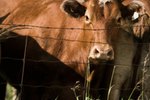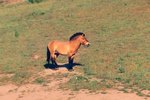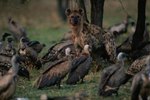
With its eye-popping black-and-white stripes, the zebra is one of the most recognizable animals on the planet. Wild populations of zebras reside in Africa, primarily in the southern and eastern parts of the continent. Every year zebras participate in the great migration, with millions of other animals, in a search for water.
Why Migrate
Migration, as defined by the Encyclopedia Britannica, is the movement of some or all of an animal population to and from a defined area. Each year thousands of zebra migrate in search of greener grazing pastures. It's not just zebras migrating -- they are a small part of millions of animals making an annual trek for better food and water supplies when grazing land dries up from seasonal drought.
Not Just Zebra
Zebra are just one of the millions of herbivores migrating in search of food every year. About 1.5 million wildebeests account for the bulk of migrating animals, with hundreds of thousands of zebras, antelopes and elks comprising most of the rest of the migration. Zebras and wildebeests are considered complementary grazers because they eat different parts of the same plants. The migratory animals co-exist easily on their route.
The Great Serengeti Migration
The largest migration is the annual migration of more than 2 million herbivores from the Serengeti into Kenya, a trip of about 500 miles. The migration is actually a large circle, as the zebra, wildebeests and other animals move clockwise from the southeast. The timing depends on environmental conditions, including the availability of water. The journey is tough; large groups of predators, such as lions, leopards, cheetahs and hyenas, are attracted to the masses of easy prey. As well, the migration loop crosses the Mara and Grumeti rivers, which are home to Nile crocodiles, who also enjoy dining on the migratory animals.
The Makgadikgadi Migration
The second largest migration for zebras is the Makgadikgadi migration, across the Kalahari Desert. During the course of this trip, which tends to begin around March, herds travel approximately 350 south miles to the Makgadikgadi grasslands for good grazing land. Despite the presence of a 150-mile fence erected to keep cattle safe from predatory wildlife, the zebra migration has continued to be strong in this area, with approximately 20,000 zebra migrating annually. Towards the end of the year, the herds return north.
References
- The Lonely Planet: Migration and the Masai Mara
- Smithsonian: Nothing Can Stop the Zebra
- Wild Watch: The Great Migration
- African Wildlife Foundation: Zebra
- Encyclopedia Britannica.com: Migration
- Environmental Graffiti: The Sergengeti: Host of the Greatest Overland Migration on Earth
- Audley Travel: Zebra Migration
Photo Credits
-
Jupiterimages/Photos.com/Getty Images




